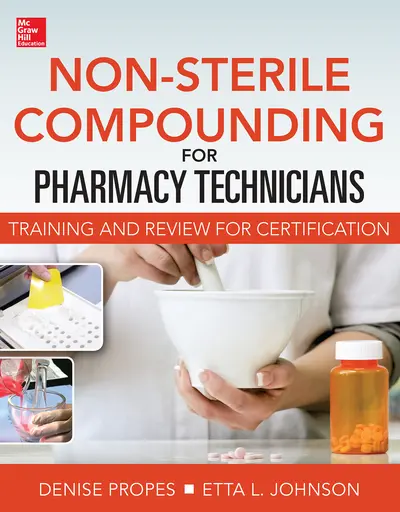My Account Details

ISBN10: 0071829881 | ISBN13: 9780071829885

Step 1 . Download Adobe Digital Editions to your PC or Mac desktop/laptop.
Step 2. Register and authorize your Adobe ID (optional). To access your eBook on multiple devices, first create an Adobe ID at account.adobe.com. Then, open Adobe Digital Editions, go to the Help menu, and select "Authorize Computer" to link your Adobe ID.
Step 3. Open Your eBook. Use Adobe Digital Editions to open the file. If the eBook doesn’t open, contact customer service for assistance.
Publisher's Note: Products purchased from Third Party sellers are not guaranteed by the publisher for quality, authenticity, or access to any online entitlements included with the product. LEARN HOW TO PREPARE QUALITY COMPOUNDED PHARMACEUTICALS IN ANY PRACTICE ENVIRONMENT Non-Sterile Compounding for Pharmacy Technicians is written to provide pharmacy technicians with a solid foundational knowledge of non-sterile compounding and toprepare them for the Pharmacy Technician Board Certification examination. It explains in detail the tools, equipment, and documents necessary to ensurethe accurate preparation of compounded pharmaceuticals. You will find easy-to-follow, step-by-step procedures for preparing liquid, solid, and semi-solid compounded dosage forms. Each chapter includes Pharmacy Technician Board Certification-style questions, calculation exercises designed to reinforce key concepts, and discussion topics to promote creative thinking. Non-Sterile Compounding for Pharmacy Technicians covers all the concepts and processes necessary to prepare the student, novice, or seasoned pharmacy technician with the tools to enter this growing pharmacy sector, or enhance their skills in order to be successful in any non-sterile compounding practice environment.
Definition of compounding
A. Differences between sterile and non-sterile compounding
A. examples of sterile products
B. examples of non-sterile products
B. Differences between manufacturing and compounding
C. Why we compound
D. USP 795
E. Compounding resources
F. Key Terms and definitions
Chapter 2- Compounding equipment/dosage formulations
A. Formulations
A. Topical formulations
a. Compounding equipment
b. Compounding techniques
B. Oral formulations
a. Compounding equipment
b. Compounding techniques
C. Rectal formulations
a. Compounding equipment
b. Compounding techniques
B. Basic Calculation refresher ( ratio-proportion)
C. General Compounding Process
Chapter 3- Topical Preparations
1.Ointments/emulsions/pastes/Creams/gels/powders/otics/ patches (explain each)
A. Recipes
B. Compounding log sheets and records
C. Expiration and storage
D. Dispensing labels
E. Calculation exercises
F. Hands on and chapter review exercises
G. PTCB exam review
Chapter 4- Oral preparations
1.Capsules/tablets/powders/lozenges/troches/sticks/ solutions/emulsions/suspensions (explain each)
A. Reconstitution
B. Flavorings for oral liquids
a. Flavoring techniques
b. Coloring
C. Pediatric dosing from adult formulations
A. Recipes
B. Compounding log sheets and records
C. Expiration and storage
D. Dispensing labels
D. Capsules/Tablets/powders /gummys/chewables
A. Sizes and properties
B. Measuring
a. Weighing
b. Inert additives
c. Over encapsulation
C. Quality assurance (+ or – 10%)
D. Comounding log sheets and records
E. Expiration and storage
F. Dispensing labels
E. Enterals/NG tube feeding
F. Calculations exercises
G. Hands on and chapter review exercises
H. PTCB exam review
Chapter 5- Rectal Preparations
A. Suppositories
B. Enemas
a. Sizes and properties
b. Inert ingredients
C. Quality assurance
D. Compounding log sheets and records
E. Expiration and storage
F. Calculations exercises
G. Hands on and chapter review exercises
H. PTCB exam review
Chapter 6- Veterinary Compounding
Chapter 7- Repackaging
Need support? We're here to help - Get real-world support and resources every step of the way.